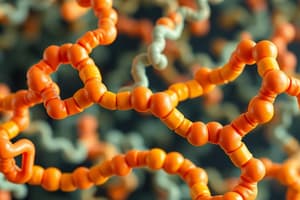Podcast
Questions and Answers
What determines the unique conformation of a protein?
What determines the unique conformation of a protein?
- The size of the protein
- The type of chemical bonds it forms
- The number of domains it contains
- The sequence of its amino acids (correct)
Why is the shape of a protein important?
Why is the shape of a protein important?
- To determine its size
- To dictate its function (correct)
- To influence its color
- To control its movement
What do extracellular proteins rely on for stabilization?
What do extracellular proteins rely on for stabilization?
- Ionic bonds
- Covalent cross-links (correct)
- Hydrogen bonds
- Van der Waals forces
Which proteins catalyze chemical reactions by binding to substrates?
Which proteins catalyze chemical reactions by binding to substrates?
What do antibodies do in the body?
What do antibodies do in the body?
What kind of interactions are crucial for establishing spatial relationships between proteins and their binding partners?
What kind of interactions are crucial for establishing spatial relationships between proteins and their binding partners?
What techniques have enabled scientists to determine the atomic structures of proteins?
What techniques have enabled scientists to determine the atomic structures of proteins?
What governs the specific shapes and functions of proteins?
What governs the specific shapes and functions of proteins?
Which biomolecule is proposed as the first genetic and catalytic molecule in the RNA World hypothesis?
Which biomolecule is proposed as the first genetic and catalytic molecule in the RNA World hypothesis?
What is the main function of proteins in living organisms?
What is the main function of proteins in living organisms?
How are close relatives among known proteins identified?
How are close relatives among known proteins identified?
What is the dominant model for the origin of life, according to scientific proposals?
What is the dominant model for the origin of life, according to scientific proposals?
Flashcards are hidden until you start studying
Study Notes
The Shape and Function of Proteins
Proteins are complex, polypeptide chains of amino acids that fold into specific structures to perform diverse functions within living cells. A protein's sequence of amino acids determines its unique conformation, which in turn dictates its function.
Protein Structure and Shape
Proteins range in size between 50 and 2000 amino acids, with larger proteins often composed of multiple structural units called domains, which fold more or less independently. The shape of a protein is critical to its function; for example, extracellular proteins are stabilized by covalent cross-links, and proteins serve as subunits for the assembly of large cellular structures.
Protein Function
Proteins bind to other molecules, such as enzymes, hormones, and antibodies, to carry out their functions. Enzymes, for instance, catalyze chemical reactions by binding to their substrates, while antibodies recognize and neutralize pathogens or toxins.
Protein-Ligand Interactions
The surface of a protein is dotted with specific chemical groups that interact with other molecules. These interactions can be categorized as hydrophobic or hydrophilic, and they are crucial to establishing the spatial relationships between a protein and its binding partners.
Protein Evolution and Sequence Homology
Proteins with similar functions often share common evolutionary origins, as indicated by their amino acid sequences. This sequence homology can be used to identify close relatives among known proteins.
Protein Structure Determination
The study of protein structure is essential for understanding protein function. Techniques like X-ray crystallography and cryo-electron microscopy have enabled scientists to determine the atomic structures of thousands of proteins, helping to reveal the fundamental principles governing protein folding and function.
Protein Origins and the RNA World Hypothesis
Scientists have proposed that proteins preceded RNA molecules in the origin of life, suggesting that proteins were the original self-replicating biomolecule. However, the RNA World hypothesis remains the dominant model for the origin of life, with RNA molecules proposed as the first genetic and catalytic molecules.
In summary, proteins are diverse and versatile molecules that serve as the building blocks and functional components of living organisms. Their specific shapes and functions are determined by their unique sequences of amino acids, which fold into complex three-dimensional structures. Proteins are involved in a wide array of cellular processes, from catalyzing chemical reactions to facilitating cellular communication.
Studying That Suits You
Use AI to generate personalized quizzes and flashcards to suit your learning preferences.




